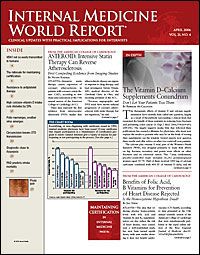Publication
Article
Internal Medicine World Report
Explaining the WHI Results to Patients
Author(s):
After the highly publicized results from the Women’s Health Initiative (WHI) involving a low-fat diet and calcium–vitamin D supplementation were published earlier this year, a host of articles appeared in the lay media suggesting that nutrition and/or supplements appear to have no bearing on our health and that following a low-fat diet may not be such a great idea after all. This was accompanied by anecdotal evidence from patients with many medical problems who were lamenting the years they had deprived themselves of fat in their diet and were ready to take their revenge by going back on a “fat diet.”
Thus, Americans may now be duly confused about their diet. The role of diet and the use of supplemental nutrients may be much more complex than most people realize, and advising your patients about the WHI results is therefore appropriate. Although we know that the human body needs fat, and that certain nutrients can only be metabolized with fat, we also know that obesity is the main epidemic today spurring other epidemics, such as diabetes, that are sweeping this country; we know that excess weight translates into many health problems. Although I am personally not an advocate of low-fat anything, the type of fat and highly processed foods are a problem for many Americans. The take-home message from the WHI for your patients is not the lack of benefit of a low-fat diet; the results must be put in the correct context, as Dr Myerson clarifies in this issue, while also providing useful suggestions on what to tell your patients and what these results really mean (page 13).
The question of calcium–vitamin D supplementation for the prevention of fractures, also based on the WHI results, is addressed in the in-depth article (pages 1, 12), which offers fresh insights from several medical authorities on what went wrong with this study and why you should tell your patients that these supplements do have health benefits that cannot always be duplicated by diet alone.
Furthermore, another analysis of the WHI results, albeit much less sexy than the others and possibly therefore ignored by the lay media, shows that when used in dosages higher than currently recommended, the calcium–vitamin D combination significantly reduces one’s risk for diabetes—by as much as one third (see page 15).
It is quite possible that the study of nutrients and supplements requires a different approach from pharmaceutical products, in part because many patients are self-prescribing supplements, and so the amount used in a study may not add much to what they already take on their own, or some may be so deficient in the particular nutrient that using the recommended dosages—currently the model for most clinical studies—may be insufficient to produce any meaningful outcomes. Perhaps one conclusion from these studies would be the need to reassess the recommendations for daily vitamin and mineral intake. This in itself would be a positive step.
Finally, accompanying the maintaining certification insert in this issue (page 8a), Dr Baron, director of the American Board of Internal Medicine, explains the rationale for the certification requirements and why it is in the best interest of all practicing internists to participate in this process (page 6). I am sure you will find his comments intriguing and hope you will write to tell us about your personal experience with this endeavor.
Dalia Buffery, Editor





